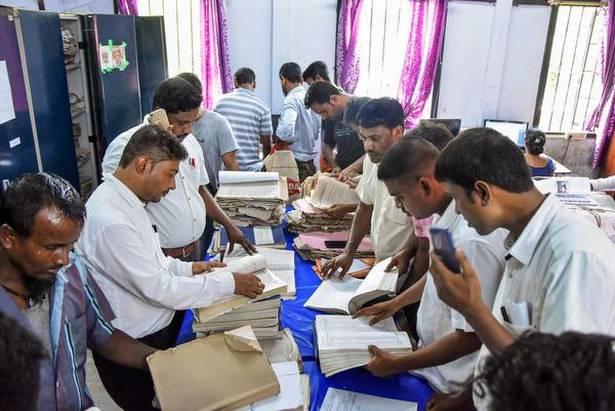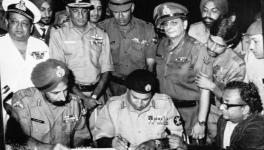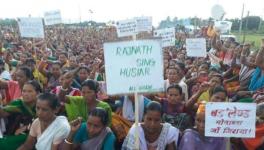NRC in Perspective: What Can't Be Cured, Has to Be Endured

Image Courtesy: The Hindu
It is said that there are three kinds of lies in the world: lies, damn lies, and statistics. Over the years, the way in which Government of India has dished out figures about illegal Bangladeshis in India, one cannot help but conclude that it believes in the adage. After all, if the government actually knew the numbers, their statistics would not have swung between two and twelve million.
Amit Shah, Bharatiya Janata Party chief and India’s current Home Minister, has made even more outlandish claims. During rallies leading up to the 2019 parliamentary election, he thundered, ‘These crores [ten million make a crore] of illegal Bangladeshis are like termites.... As soon as we win in the election we will identify each one of them and push them back to Bangladesh.’
Mercifully, Shah did not take his promise to its logical, macabre end. An infestation of termites is eradicated only by the use of pesticides. Once you label a people as such, the historical precedents take you directly to Hitler’s gas chambers and his attempt to accomplish a ‘final solution’ to the ‘Jewish problem’. Instead, Shah satisfied his audience by making the impossible promise that all illegal Bangladeshis will be pushed ‘back to Bangladesh’, the likelihood of which the Modi government has now categorically put to rest.
Also read: Life After NRC: How to Control Hindu Rashtra Fantasies
The cat is now out of the bag. After a 5-year long exercise in Assam, involving about 50,000 personnel and incurring an expenditure of over Rs 1,200 crore, 19,05,657 individuals have been identified as ‘non-citizens’, after being excluded from the final list of the National Register of Citizens (NRC). This figure is significantly lower than any figure the government has generally quoted. The number is sure to fall even further once appeals during the 120-day grace period are processed. As and when the entire process is completed, the number of illegal Bangladeshis will be embarrassingly small for all those who conjured up images of countless 'termites'.
And whatever the ultimate figure, we also know it will not be accurate. In the poor, illiteracy-ridden Third World there are inherent problems with such counts. Kamal Sadiq’s study, Paper Citizens, on illegal immigrants in the developing world, with particular reference to illegal Afghans in Pakistan, provides empirical confirmation of this basic reality. When the poor do not even have a secure place to keep their meagre financial savings, it is bizarre to think that they will preserve pieces of paper whose contents they cannot read.
Among the mundane yet stubborn problems is how to deal with names that are spelt differently across cultural settings. I can refer to one such instance from personal experience. On April 28, 2014, a massive fire gutted a large number of shanties in Delhi’s Vasant Kunj area. The victims were mostly Bengali-speaking Muslims from North Bengal. Presumably, some among them were illegal Bangladeshis who had acquired Indian ration and Aadhaar cards, becoming what Sadiq would describe as ‘paper citizens’.
The Delhi administration decided to issue cheques of Rs 5,000 as immediate relief to each affected family. But cheques require names and names require consistency of spelling. The administration issued the cheques in English, using spellings that match Urdu pronunciations: Umar for Omor, Jamila for Jomila, Sahid-ul for Shohidul, Jawaid/Javed for Jabed, and so on. Unable to demonstrate that the cheques were indeed for them, legitimate beneficiaries were denied relief.
As a Bengali, I immediately understood the problem and offered to help. I wrote directly to the then Lt Governor of Delhi, Najeeb Jung, to explain the issue and help negotiate the communication gap. I do not know whether my explanatory note helped, but the matter was soon resolved in favour of the affected. In the context of the NRC, we are beginning to see an increasing number of similar snags. Not merely Muslim names, even Hindu and tribal names have been mangled across linguistic lines.
Also read: Assam: ‘Arbitrary Powers’ to FTs While People Are Set to Face Citizenship Test
These are, however, smaller issues. Assam’s real problems are its multidimensional faultlines. To mention just a few: linguistically, Assamese versus Bengali; communally, Hindu versus Muslim; intra-communally, Assamese-speaking Muslims versus Bengali-speaking Muslims (so-called Miya), as well as caste Hindu versus lower caste Hindu; ethnically, tribals versus non-tribals on the one hand, and plains tribes versus hill tribes on the other; regionally, Upper Assam versus Lower Assam; and finally, in terms of affirmative action, Scheduled Tribes (STs) versus potential STs (six communities are currently demanding ST status).
At the supra level, there is an overarching concern among the Assamese of cultural marginalisation, which has been at the core of the Assam movement since the late 1970s. With the recent rise of the BJP at the centre and in the state, these cleavages have sharpened in two contradictory ways. The BJP’s Hindutva push fits well with the movement’s anti-Muslim dimension, but its proposed amendment to the citizenship act, which is sympathetic to Hindu immigrants, irks the linguistic nationalism of the Assamese.
Recall that the BJP’s bigger goal in East India is to corner the support of the Bengalis, who are the region's dominant linguistic group across Assam, Tripura and West Bengal. Added to the calculation, the impending West Bengal Assembly elections in 2021, BJP may well decide to turn a Nelson’s eye to the essential thrust of the Assam movement, that is, ‘Assam for the Assamese’. Sacrificing a smaller pie for a bigger pie is common sense politics, after all.
No wonder, therefore, that even liberal Assamese intellectuals like Hiren Gohain were up in arms against the Citizenship (Amendment) Bill 2016. The progressive streak in him made him oppose the bill on the grounds that it compromised India’s constitutionally ordained secular commitment, but his sense of Assamese-identity-in-danger made him take the maximalist position that Assam might even be forced to think in terms of seceding from the Indian Union.
There is no denying the fact that during the last hundred years massive migrations have taken place from East Bengal into Assam, upsetting the original demography of the region. The spark that set ablaze the prairie fire of Assamese insecurity was lit in 1931. In that year, the British superintendent of the Assam census, C.S. Mullan, made the following combustible remark: ‘Probably the most important event in the province during the last twenty-five years… has been the invasion of a vast horde of land-hungry Bengali immigrants, mostly Muslims… [as a result of which] in another thirty years Sibsagar district will be the only part of Assam in which an Assamese will find himself at home.’
Also read: Politics and Ramifications of the NRC in Assam
As Gohain notes, it was a classic case of British imperialism of ‘running with the hare and hunting with the hounds’. After all, it was the Permanent Settlement of revenue collection in Bengal that had created the class conflict between Hindu zamindars and an impoverished Muslim farming community, which was in turn prodded to migrate to Assam in search of greener pastures. In the 1970s, when the All Assam Students’ Union (AASU) launched its stir against illegal Bangladeshi settlers, Mullan’s statement was found most handy.
But it was not merely the census of 1931 that was important. The census of 1951 (there was no census in 1941 due to war) was also critical in three respects. In the first place, Bengali Muslims declared themselves as Assamese-speaking, which contributed to the cooling down of Hindu Assamese hostility against the Muslims. With the communalisation of the Assam movement, this has become increasingly irrelevant, however.
Shalim Hussain, a Bengali Muslim, laments in one of his recent writings that it is the constant refrain of his community that when they could not speak Assamese they were ridiculed for clinging on to their Bengali roots but now that they can fluently speak the language, they are accused of ‘putting on a show’--a case of heads the Assamese win, and tails the miyahs lose.
Second, the separation of Sylhet, which contained 30% of Assam’s population, 90% of whom spoke Bengali, following a referendum just before Partition made Assam an Assamese-majority state for the first time. As a result, the percentage of Assamese in the population increased from 30 in 1930 to 56 in 1951.
Third, a new distinction emerged post-1951 with respect to Muslim immigrants from East Bengal and their Hindu counterparts. While the latter were recognided as ‘refugees’, the former came to be seen as ‘illegal immigrants’ or ‘foreigners’. It may be noted that The Immigrant (Expulsions from Assam) Act 1950 implicitly distinguished the Hindu refugee from the Muslim immigrant. Although, this act was repealed in 1957, there was a 1965 secret administrative order of the Government of India that authorised the district magistrate to grant Indian citizenship to those Hindu refugees from East Pakistan who had settled in Assam for six months or more.
Parenthetically, one can find similarities between this 1951 development and what happened in Punjab. In the same census, many Hindu Punjabi refugees had declared Hindi as their language, which eventually led to a political rift between Punjabi Sikhs and Punjabi Hindus, and contributed to the germination of the Khalistan movement in the 1970s and 1980s.
The cumulative effect of all these developments is that Assam is chronically disturbed. Now, with the overdose of religion injected into Assam’s body-politic thanks to the BJP’s Hindutva thrust, things are poised to unravel, with the repercussions inevitably extending into neighbouring Bangladesh as well. However much India may clarify that no illegal Bangladeshi in India will be pushed into Bangladesh (as if Bangladesh is going to accept any of them), the emotive content in the promise is humiliating enough to make Bangladeshi Islamists enlarge their constituency and dream of a return to power.
Politics is existential; but existentialism should have its limits. Demographic changes that happen for historical reasons cannot be reversed by quick-fix political engineering. They warrant statesman-like handling based on human rights and larger calls to multiculturalism, ideals that are embedded in the currently much maligned ‘idea of India’.
Human history is replete with migratory movements and though it is politically fashionable these days to denounce immigrants, particularly, if they are Muslims, as can also be seen in many parts of Europe, the end result is bound to be naught. Moreover, since the West is rich, it can ward off the ‘problem’, much as Australia and Denmark have done in their own ingenious ways. The Third World can ill afford to just throw away immigrants. Notably, contrary to the advertised greatness of the West, much larger numbers of immigrants have been absorbed within the Third World for cultural reasons.
Also read: BJP Opposes NRC in Assam But Pushes It Across Country
One last point, the middle class Indians who ridicule Bangladeshi immigrants must look to their own hankering for American green cards, if not American citizenship. Moreover, of the U.S. population of about 330 million, about 10.7 million, 3.3%, are illegal immigrants. With India’s population at 1.3 billion, 3.3% of that would translate to about 43 million. Are we Indians not becoming unnecessarily panicky in the face of this suspected Bangladeshi influx?
Let Indians also be reminded, as Neeraj Kaushal writes in her book Blaming Immigrants, ‘In proportion to world population, the number of global immigrants – people living outside their country of birth – is a modest 3%. Not a deluge, not a surge, not a flood, not even a stream, but a trickle.’ This has been the reality for the last hundred years.
To see it from another perspective, even if India has 10 million illegal Bangladeshis it would mean less than 1% of India’s population. Indian Americans today constitute 1% of America’s population. After the Jews, they are the richest ethnic group in the United States. Most middle class Indians, BJP supporters in particular, are proud of them. But for the poor Bangladeshis only revulsion seems to be in store.
Postscript: Any border re-demarcation collaterally harms one community or the other. The transfer of Sylhet to Pakistan in 1947 subjected the Sylheti Bengalis to a double jeopardy. In search of security they first migrated to Shillong, then Assam's capital and a safe destination. But upon the creation of Meghalaya in 1972, Shillong became Meghalaya’s capital and its politics was overtaken by Khasi chauvinism. This chauvinism subjected the immigrant Bengali community to utter humiliation, including instances of rape in broad daylight. The situation became so unbearable that Sylheti Bengalis were once again forced to migrate, this time out of Meghalaya, enduring a double displacement in one lifetime.
The author is a senior fellow at the Institute of Social Sciences. The views are personal.
Get the latest reports & analysis with people's perspective on Protests, movements & deep analytical videos, discussions of the current affairs in your Telegram app. Subscribe to NewsClick's Telegram channel & get Real-Time updates on stories, as they get published on our website.
























